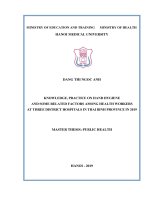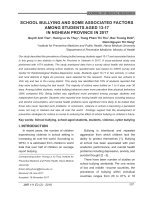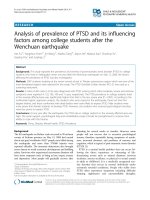School bullying and some associated factors among students aged 13-17 in Nghe An province in 2017
Bạn đang xem bản rút gọn của tài liệu. Xem và tải ngay bản đầy đủ của tài liệu tại đây (234.06 KB, 7 trang )
JOURNAL OF MEDICAL RESEARCH
SCHOOL BULLYING AND SOME ASSOCIATED FACTORS
AMONG STUDENTS AGED 13-17
IN NGHEAN PROVINCE IN 2017
Quynh Anh Tran1, Huong Le Vu Thuy1, Trang Pham Thi Thu1, Bac Truong Dinh2,
Diem Nguyen Thi Hong2
1
Institute for Preventive Medicine and Public Health, Hanoi Medical University
2
Department of Preventive Medicine, Ministry of Health
Our study described the prevalence of being bullied among students aged 13-17 and associated factors
in this group in two districts in Nghe An Province in Vietnam in 2017. A cross-sectional study was
performed with 1074 students. The study ananlyzed data from a survey about health risk behaviors
and associated factors among school students. Its questionnaire was based on GSHS survey and
Center for Epidemiological Studies-Depression scale. Students aged 13-17 in two schools, in urban
and rural districts in Nghe An province, were selected for the research. There were two schools in
Vinh city and two in Do Luong district. This study has identified that 16% of students reported that
they were bullied during the last month. The majority of victims were bullied on 1 to 5 days over 30
days. Among bullied students, verbal bullying behaviors were more prevalent than physical behaviors
(38% compared 9%). Being bullied was significant more prevalent among younger students and
independent form gender. Students who reported ever having health risk behaviors including tobacco
and alcohol consumption; and mental health problems were significant more likely to be bullied than
those who never reported such problems. In conclusion, violence in school is becoming a persistent
issue not only in Vietnam but also all over the world. Findings support that the development of
prevention strategies for victims is crucial to reducing the effect of school bullying on children’s future.
Key words: School bullying, school-aged students, students, violence, cyber bullying
I. INTRODUCTION
In recent years, the number of children
experiencing violence in school setting is
increasing all over the world. Accroding to
WHO, it is estimated from children’s world
data that over half of children on average
report bullying.
Corresponding author: Huong Le Vu Thuy, Institute for
Preventive Medicine and Public Health, Hanoi Medical
University
Email:
Received: 06 June 2017
Accepted: 16 November 2017
JMR 111 E2 (2) - 2018
Bullying is intentional and repeated
aggression from which children lack the
ability to protect themselves [1]. Bullying
at school has been associated with poor
academic performance, and mental health
problems including depression, anxiety, and
suicidal thought [2 - 5].
There have been number of studies on
school bullying worldwide. Per one review
of low and middle –income countries, the
prevalence of bullying within individual
countries ranges from 20 to 61% in 18
107
JOURNAL OF MEDICAL RESEARCH
countries, and Tajikistan was the country
only with a prevalence of bullying of less
than 20% [6]. In the United State, data from
a recent Youth Risk Behavior Surveillance
showed that more than one- fifth of students
are bullied on school property during 12
months
[7]. The Global School-based
Student Health Survey (GHSH) in China
found that around 32% of students were
bullied over the past 30 days. In South East
Asia, the figures in Singapore revealed
that about a quarter of secondary school
students and one- fifth of primary school
students were victims of bullying [8].
Another study in Turkey showed that 22%
were victims, 9.4% were bully/victims and
9.2% were bullies [9]. In German, Richter
showed that 17% of boys and 10% of girls
from 11 to 15 years old were classified as
repeated bullying perpetrators [10].
Although studies on school bullying have
been conducted in several sites in Vietnam,
there is a lack of data on school students
who are bullied in Nghe An province.
The aims of this study are to describe the
prevalence of being bullied among students
aged 13 - 17 and associated factors in two
districts in Nghe An Province in Vietnam in
2017
II. SUBJECTS AND METHODS
1. Subjects and recruitment
This study used a cross-sectional
study design. By using a formula, the
minimum sample size was estimated to
be 412 students. To be more precise,
once multiplied with design effect and a
sample size of at least 824 students was
determined necessary. In fact, a total of
108
1074 participants involved. The following
formula was used to estimate the sample
size for a proportion of the population.
n = Z21-α/2 x
p(1- p)
d2
p= 0.22 (Le Thi Hai Ha 's study) [9];
= 1.96 (95%CI) and d = 0.04.
In Nghe An Province, located in the centre
of Vietnam, some cases of school bullying
were reported among students in grade 6
to 12 via the internet. Therefore,Vinh city, in
a rural district, and Do Luong district, in a
urban one, were selected. In each location,
a secondary school and high school were
chosen, namely Hong Son secondary
school (282 participants) and Le Viet Thuan
high school (274 participants), located in
Vinh city, and Nguyen Thai Nhu secondary
school (270 participants) and Do Luong III
high school (248 participants) in Do Luong
district.
In secondary schools, students from
grades 7, 8 and 9 were collected. In high
schools students form grades, that is 10
and 11 were collected. Eventually, in each
grade, three or four classes were randomly
selected based on the sizes of classes and
all students in chosen classes were eligible
to participate. Data was collected in the
class setting . First, researchers explained
to students the aim of the survey and how to
complete the questionnaire. The researchers
also expressed that participation was
voluntary. After that, it took 15 to 30 minutes
for students to fill out questionnaire, which
researchers collected directly. There were
around 20 to 40 students in a class.
JMR 111 E2 (2) - 2018
JOURNAL OF MEDICAL RESEARCH
2. Methods
Instrument and data collection
We had applied GSHS questionnaire
that was made by WHO to help countries
measure the behavioural risk factors and
protective factors among young people
aged 13 to 17 years. It focused bullying and
determined current both bullying prevalence
(during past 30 days) and types of bullying
behaviors. Mental health problems (feelings
of loneliness, being worried, hard focus,
and suicide attempt) and health risk
behaviors (alcohol consumption, drug use,
and tobacco use) were also collected.
Data analysis
The data was entered into EPI and
analyzed using STATA 12.0. Descriptive
statistics, odds ratios with 95% CI
(Confidence Interval), and Pearson Chi square tests were used to describe all the
variables. All missing or illogical data were
excluded from the analysis
3. Ethics
In the study, all students were given the
choice to participate and were assured that
their answers would remain anonymously.
All personal identities of the respondents
were protected. The survey was performed
with agreement of school leaders and the
Nghe An Department of Education and
Training
III. RESULTS
1. General description of the
participants
The proportion of boys was lower than
that of girls: 45.8% versus 54.2%. In term
of a total of 1074 participants (with the
respondent rate is 100%), the percentage
JMR 111 E2 (2) - 2018
of respondents aged from 13 to 15 years
old was 49.8% compared to 50.2% of those
aged 16 and 17 years old. The percentages
of urban and rural areas were 51.8 and
48.2 respectively. There were about 14.1%
of total students who reported that they do
not have any close friends to confide in.
Regarding BMI, the proportions of normal
and underweight students were at with
46.4% and 49.6% respectively, while 4%
of students were classified as overweight/
obese
The proportion of alcohol consumption
was the highest (one of three) health
risk behaviors with about 20.5% of total
students reporting alcohol use, followed by
8% of participants reporting tobacco use.
Approximately 80% of total respondents
reported that they had diffculty concentrating
during the last 12 months; followed by
70% of students reporting they felt lonely
during the past 12 months. In addition,
more than half of students reported being
worried during that period. Finally, the rate
of participants who had attempt suicide was
around 10%.
2. Prevalence of being bullied among
students aged 13-17 in Nghe An
province in Vietnam
The overall past 30 days prevalence
of school bullying was 16%. The majority
of students were bullied on 1 to 2 days,
constituting for 9.8%, followed by 2.7%
of participants who suffered from school
bullying on 3 to 5 days. 1% of students
reported bullying for at least 6 days, and
1.4% of respondents reported being bullied
all 30 days.
109
JOURNAL OF MEDICAL RESEARCH
Table 1. Types of bullying behavior by personal characteristics of bullied students
Physical
bullying
Characteristics
Gender
Age group
Region
Friendship
BMI
Verbal
Others
Total
bullying (%)
(%)
30 (35.7)
51 (60.7)
84
Girl
(%)
3 (3.6)
Boy
12 (13.6)
35 (39.8)
41 (46.6)
88
13 -15
9 (9)
40 (40)
51 (51)
100
16 – 17
6 (8.3)
25 (34.7)
41 (57.0)
72
Urban
7 (8.8)
36 (45.6)
36 (45.6)
79
Rural
8 (8.6)
29 (31.2)
56 (60.2)
93
Yes
13 (9.0)
52 (36.1)
79 (54.9)
144
No
2 (7.4)
12 (44.4)
13 (48.2)
27
18.5 to 24.99
10 (12.8)
32 (41.0)
36 (46.2)
78
Under 18.5
5 (5.6)
31 (34.8)
53 (59.6)
89
Over 25
0
2 (40)
3 (60)
5
3. Associated factors to being bullied among school students
Table 2. Association between personal characteristics and being bullied among
school students
Bullied
students
Characteristics
Gender
Age Group
Region
Friendship
BMI
110
OR (95%CI)
n
%
Girl
84
14.5
1.0
Boy
88
17.9
1.3 (0.9 - 1.8)
13 -15
100
18.7
1.5 (1.1 - 2.1)
16 – 17
72
13.4
1.0
Urban
79
14.2
1.0
Rural
93
18.0
1.3 (1 - 1.8)
Have close friends
144
15.8
1.0
Have no close
friend
27
18.0
1.2 (0.7-1.8)
18.5 to 24.99
78
15.7
1
Under 18.5
89
16.7
1.1 (0.8-1.5)
Over 25
5
11.6
0.7 (0.3-1.9)
p - value
> 0.05
0.017 < 0.05
> 0.05
> 0.05
> 0.05
JMR 111 E2 (2) - 2018
JOURNAL OF MEDICAL RESEARCH
Table 2 presents, according to age group, the propotion among 13-15 year-old students
roughtly one in five, whist it was 13,4% among those of 16-17.
Table 3. Association between mental health problem and being bullied
among school students
Bullied students
Mental health
problems
Loneliness
Being worried
Hard focus
Suicide attempt
N
%
Ever
137
18.4
Never
34
10.4
Ever
121
20.2
Never
50
10.6
Ever
151
17.7
Never
19
8.8
Ever
35
31.8
Never
137
14.2
OR
1.9 (1.3-2.9)
p- value
0.001 < 0.05
2.1 (1.5-3.1)
< 0.05
2.2(1.3-3.7)
0.001 < 0.05
2.8 (1.8-4.4)
< 0.05
Table 3 indicates that mental health problems were associated with being victim of
perpetration among school students. There is also evidence that students with mental health
problems were significant likely to be perpetrated than those who had no any psychiatric
problems.
29.1% of respondents who had ever smoked reported that they were bullied during the
past 30 days. In participants using alcohol at least one drink during their lives, 25.5% of them
reported being bullied. Statistically, students who had ever used tobacco and alcohol were
associated with being bullied. The prevalence of being bullied among students who had ever
consumed drug in their lifetime was nearly 30%. Although the odd ratio was reasonably high,
there was no significant association between drug use and being a victim
IV. DISCUSSION
Findings of current study indicated that nearly 16% of total students reported being bullied
over the past 30 days. This prevalence was lower than figures reported in previous studies
conducted in Vietnam .and other countries, which reported a range from 20-50% bullying
victims among school students [7, 8].
These distinctions can be explained by the discrepancies between sample sizes,
instruments used or the time period when studies were carried out or even geographic
features.
This current research investigated the percentages of each type of bullying behaviors
JMR 111 E2 (2) - 2018
111
JOURNAL OF MEDICAL RESEARCH
and differences in bullying among gender,
age, region, friendship, and BMI. With
regard to age, the percentage of both age
groups suffering from physical behaviors
were almost equal at around 9%, while the
proportion of younger students who reported
verbal behaviors were both around 40%,
much higher than the percentage amongst
older students. This was in accordance
with previous findings [6,11]. As for distinct
geographies, the percentages of urban
students who reported physical and verbal
bullying behaviors were 8.8% and 45.6%,
higher than percentage of students rural
(8.6% and 31.2% respectively). A recent
study on cyber bullying among high school
students in three provinces of Vietnam also
reported a higher figure in urban areas [12]
As for age, in accordance with findings
from previous studies, literature shows
higher prevalence of bullying among
younger students. For instance, Indonesia
GSHS data suggests higher prevalence of
victimization in 13 - 15 year-old students
than in 16 -17 year-old students. This
current study also indicated that being
bullied was more prevalent among
younger participants (p < 0.05). Our study
investigated health risk behaviors including
tobacco and alcohol consumption. These
results are in accord with recent studies all
over the world indicating the association
between being bullied and engaging in
certain health behaviors [11]. In Vietnam,
there were the similar results in GSHS 2013
(2014). Although the OR was reasonably
high, there was no significant association
between drug use and being a victim. This
could be due to sampling sizes. In future
112
studies we should increase the size of out
sample.
This current study detects a strong
association between being bullied and
suffering from certain psychiatric problems
among students. Respondents who reported
having one in four mental disorders including
loneliness, being worried, hard focus, and
suicide attempt were significant more likely
to report being bullied than students who did
not possess any mental health problems (p
< 0.05). These results seem to be consistent
with previous research in both Vietnam and
other countries [14,15].
V. CONCLUSION
The majority of victims were bullied on
1 to 5 days in all 30 days and totalled 16%
of students. Among bullied students, verbal
bullying behaviors were more prevalent
than physical behaviors. Students who were
bullied were significantly more prevalent
among younger students but were and
independent of gender. Students who had
health risk behaviors including tobacco,
alcohol consumption, loneliness, being
worried, difficulty focusing, depression and
suicide attempts were significant more
likely to being bullied than those who never
reported mental health problems (p < 0.05).
Additionally, the prevalence of being bullied
among students who had ever reported one
or two health risk behaviors was significant
higher than that for those who had not.
Acknowledgements
The authors thank the Department of
Preventive Medicine - Ministry of Health for
funding for this study.
JMR 111 E2 (2) - 2018
JOURNAL OF MEDICAL RESEARCH
REFERENCES
1. Olweus D (2013) School bullying:
developmental and some important
challenges. Annu Rev Clin Psychol. 9, 751780.
2. Arseneault L, Bowes L, Shakoor
S (2010) Bullying victimization in youths and
mental health problems: Much ado about
nothing? Psychol Med. 40, 717 - 729
3. Campbell M, Spears B, et al.,
(2012) Victims perceptions of traditional
and cyberbullying, and the psychosocial
correlates of their victimization. Emot Behav
Diffic. 17, 389 - 401
4. Tran PB, Nguyen HT, et al., (2013)
Factors associated with health risk behavior
among school children in urban Vietnam.
Global Health Act. 6, 1 - 9
5. Ha Thi Hai Le, Michael P.
Dunne, Marilyn A. Campbelld
et al
(2017) Temporal patterns and predictors
of bullying roles among adolescents in
Vietnam: a school-based cohort study.
Psychology, Health & Medicine, DOI:
10.1080/13548506.2016.1271953
6. Fleming L.C. and Jacobsen
K.H. (2010). Bullying among middleschool students in low and middle income
countries.Health PromotInt. 25(1), 73 – 84
7. Kann L. (2016). Youth Risk
Behavior Surveillance—United States,
2015.MMWR SurveillSumm, 65
JMR 111 E2 (2) - 2018
8. Koh C.W., Tan A., Tan B.C., et
al. (2008), Bullying in Singapore schools,
Singapore Children’s Society, Singapore.
9. Alikasifoglu M., Erginoz E.,
Ercan O., et al. (2007). Bullying behaviours
and psychosocial health: results from a
cross-sectional survey among high school
students in Istanbul, Turkey. Eur J Pediatr.
166(12), 1253
10.Richter M., Bowles D., Melzer
W., et al. (2007). Bullying, psychosocial
health and risk behaviour in adolescence.
Gesundheitswesen. 69 (8-9), 475 - 482.
11. Gan S.S., Zhong C., Das S., et
al. (2014). The prevalence of bullying and
cyberbullying in high school: a 2011 survey.
Int J Adolesc Med Health. 26(1), 27 – 31.
12. Pham Thi Thu Ba, Tran Quynh
Anh (2016) Cyberbullying among high
school students and some related factors,
Journal of Medical Research. Vol 104, No
6, 35 - 42
13.Ha Thi Hai Le, Huong Thanh
Nguyen, Marilyn A. Campbell (2016)
Longitudinal associations between bullying
and mental health among adolescents in
Vietnam. Int J Public Health DOI 10.1007/
s00038-016-0915-8
14. Vaughn M.G., Fu Q., Bender K., et
al. (2010). Psychiatric correlates of bullying
in the United States: findings from a national
sample. Psychiatric Q. 81(3), 183 – 195.
113









